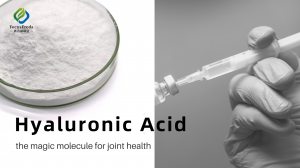Hyaluronic acid: the Magic Molecule for Joint Health
Joints are an important part of the human body. They not only carry our weight, but are also responsible for the body’s movement functions. However, as age increases and lifestyle changes, joint diseases such as arthritis become increasingly common, posing considerable challenges to people’s quality of life. In recent years, hyaluronic acid, as an important bioactive substance, has gradually attracted people’s attention for its role in joint health care. This article will explore the use of hyaluronic acid in the treatment of joint diseases and investigate its mechanism in joint fluid lubrication and pain relief.
1. Introduction to hyaluronic acid
Hyaluronic Acid (HA) is a polysaccharide naturally present in the human body, which is especially abundant in joint fluid, skin, eyes and other parts. It has excellent water-retaining properties and is able to absorb large amounts of water, providing necessary lubrication and nourishment to tissues. Hyaluronic acid plays a vital role in the joints, helping to maintain their normal function and health.
2. Application of hyaluronic acid in the treatment of joint diseases
- Arthritis treatment
Arthritis is a common joint disease characterized by joint pain, swelling, and dysfunction. As one of the main components of synovial fluid, hyaluronic acid has significant advantages in the treatment of arthritis. By injecting hyaluronic acid into the joint cavity, hyaluronic acid lost in the joint fluid can be replenished, thereby improving the viscosity and lubricity of the joint fluid and reducing joint wear and pain. In addition, hyaluronic acid also has anti-inflammatory effects, which can reduce joint inflammatory reactions and further alleviate the condition.
- Joint function recovery
When treating joint diseases, hyaluronic acid not only helps relieve pain and swelling, but also promotes the recovery of joint function. By improving the lubricating properties of synovial fluid, hyaluronic acid can reduce joint friction during movement and reduce the risk of joint injury. At the same time, hyaluronic acid can also promote the repair and regeneration of articular cartilage, helping to restore the normal structure and function of joints.
3. The mechanism of hyaluronic acid in joint fluid lubrication and pain relief
- Lubrication mechanism
The lubricating effect of hyaluronic acid in synovial fluid is mainly due to its unique molecular structure and water-retaining properties. Hyaluronic acid has long molecular chains and is rich in negative charges, and can absorb large amounts of water to form a highly viscous gel-like substance. This gel-like substance can fill the surface of articular cartilage and form a lubricating film to reduce friction and wear during joint movement. In addition, hyaluronic acid can interact with other components in synovial fluid to jointly maintain the lubrication properties of synovial fluid.
- Pain relief mechanism
Hyaluronic acid also plays an important role in reducing joint pain. First, by improving the lubricating properties of synovial fluid, hyaluronic acid can reduce friction and wear of joints during movement, thereby reducing pain. Secondly, hyaluronic acid has anti-inflammatory effects, which can reduce joint inflammatory responses, reduce the stimulation of joint tissues by inflammatory mediators, and further relieve pain. In addition, hyaluronic acid can also promote the repair of articular cartilage, help restore the normal structure and function of joints, and reduce pain from the source.
Conclusion
As an important component of joint fluid, hyaluronic acid plays a pivotal role in joint health care. By supplementing hyaluronic acid in joint fluid, the lubrication properties of joint fluid can be improved, joint wear and pain can be reduced, and joint function recovery can be promoted. Therefore, hyaluronic acid has become an attractive treatment method when treating joint diseases. In the future, with the deepening of research and the continuous advancement of technology, hyaluronic acid will be more widely used in the field of joint health care, bringing good news to more patients with joint diseases.
Ingredients
Hyaluronic Acid & Tremella Fuciformis Polysaccharide
Collagen & Chondroitin Sulfate
Contact Us
 Address
Address
 Email
Email

© Copyright - 2010-2025 : All Rights Reserved. Hot Products - Sitemap
Freda Sodium Hyaluronate Powder,
Food Grade Sodium Hyaluronate Powder,
Sodium Hyaluronate Powder,
Food Grade Sodium Hyaluronate,
Sodium Hyaluronate Structure,
Concentrated Sodium Hyaluronate,







